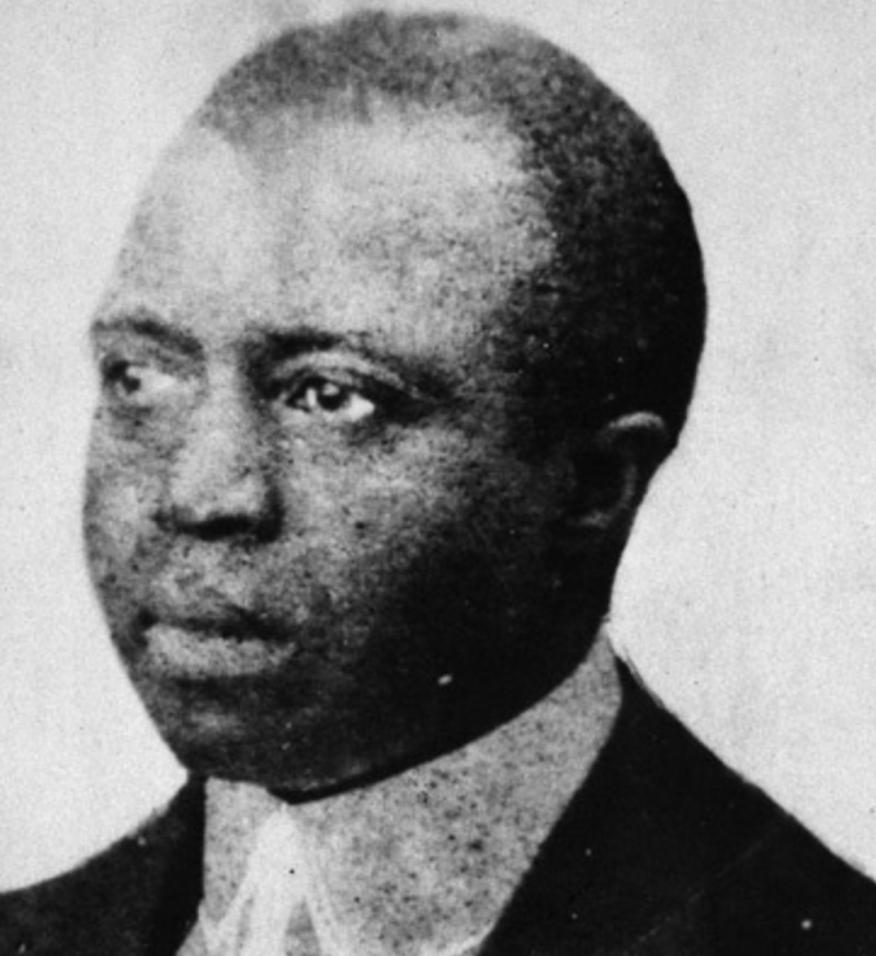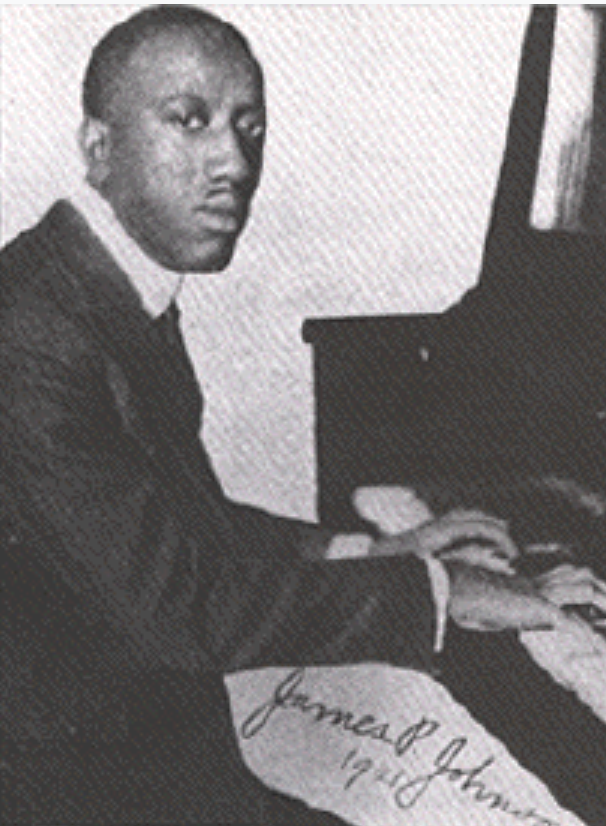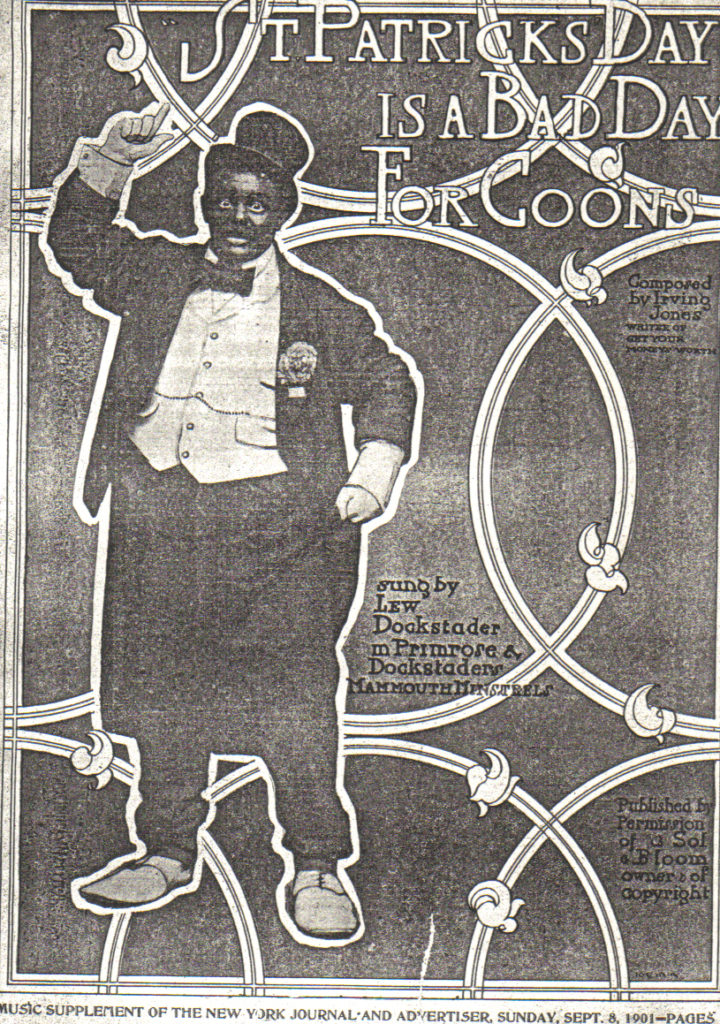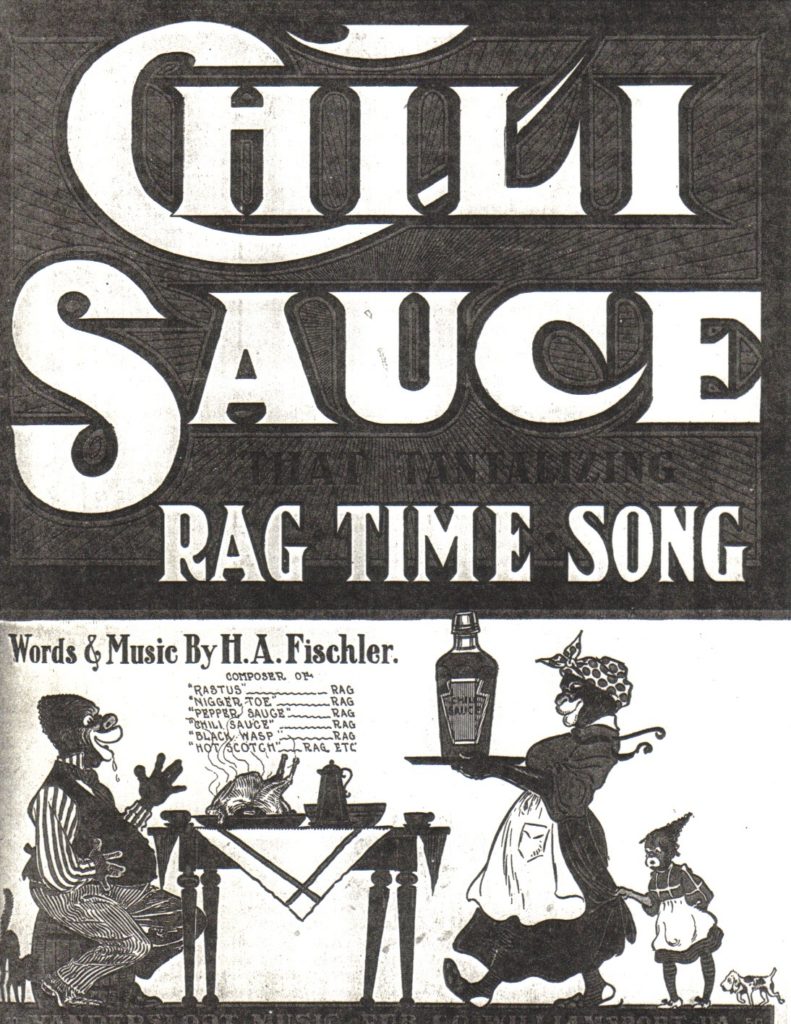After the Civil War, Black and White cultures were thrown into new relationships. For a time there was a predominance of White, often Irish, song styles. Some hits of the era were “When You and I Were Young, Maggie” (1866), “Silver Threads Among the Gold” (1872), “I’ll Take You Home Again, Kathleen” (1875), “Grandfather’s Clock” (1875), and “Clementine.” Popular songs were sold in sheet music to be sung in parlors with pianos, and on the stage.
But something else was afoot. Out of the ashes of slavery came Black musicians filling the streets of the South, and out of the ashes of minstrelsy arose the Black musicians who developed ragtime. As Donald Clarke put it, “The history of modern popular music may be seen as the repeated rescuing of a moribund scene by the music of African-Americans.”[i]
Ragtime was an African‑American version of European march music, combined with Black dance rhythms, played on the banjo, then the piano, and later by brass bands. Rhythmically, it descended from a minstrel march known as the patrol, which had become syncopated by the 1880s,[ii] and from the cakewalk, its immediate predecessor as a commercial craze. The first ragtime piano piece was subtitled a “Banjo Imitation,” indicating its probable origins among African-American minstrels.[iii] Among the pianists who wrote ragtime were Scott Joplin—inspired by his mother’s banjo picking—and Tom Turpin, James Scott, and Eubie Blake, along with Joseph Lamb, a White musician and friend of Joplin’s. Other White rag writers included May Aufderheide and Irene Giblin.[iv]

The distinctive rhythms may also have descended from the African-American body percussion tradition known as “patting juba,” a slapping, tapping, and hand-clapping described thus in 1899:
The division of one of the beats into two short notes [in ragtime] is perhaps traceable to the hand-clapping; every American is familiar with the way the darkey pats his hands with two quick slaps alternating with the time-beating of the foot…The so-called “snap” may be traced to the quick slap of the heel and toe of the foot in sharp succession.[v]
All this slapping, clapping, and tapping had served as substitute for the banned drums, and had long since infiltrated into Euro-American cultural life. Mark Twain, in the 1870s, entertained his party guests with his versions of African American dances, and wrote in The Adventures of Huckleberry Finn of White boatsmen who patted juba.[vi], [1]
[1] This practice has been traced to the zuba dance
of the African Kongo kingdom. (Thompson, 65, 309 n.42)
Ragtime achieved colossal popularity among Whites, partly because it was similar to music they already knew, yet with a twist of syncopation that snapped them awake. The bass remained true to the march, but the melody was syncopated: notes were sounded across main beats and bar lines, followed by notes starting on weak beats, so the melody floated around the rhythm.

Rag derived from both European ballroom dance traditions, like the polka and schottische, and Afro-American dances like the cakewalk and buck dancing. Especially the cakewalk, because both the walk and the rag were clearly Black impressions of White styles. Clear to Blacks, anyway. Louis Moreau Gottschalk, a very influential composer and pianist, wrote pieces associated with the cakewalk. He hailed from New Orleans and, like Christy, was an observer of the Congo Square scene. The dancing there was described in 1886 as being in “ragged” time.[vii]
Eventually ragtime would feed into tap dancing, which combined northern English clogging, Irish step-dancing, West African stomping and African-American buck and wing. Rag was also an influence on stride piano, pioneered in New York by James P. Johnson, Eubie Blake, Willie “The Lion” Smith and Fats Waller; it is heard in southeastern blues guitar and even in Barbershop.
Besides syncopation, ragtime used techniques such as the break—a sudden stop in the rhythm, filled by a melodic line—that would become standard in jazz. Ragtime style persisted in country string bands and jug bands of a later period, and it permeates later solo guitar styles like that of Chet Atkins; it can be heard in bluegrass music to this day. Indeed, the infusion of a syncopated version of marching band music into backwoods White folks’ string music is a pretty good indication of how entangled our roots are.

Ragtime was a breakthrough because it allowed Blacks to perform without the intermediary of blackface. “Coon songs,” stereotyping the life and music of southern Blacks, had become a staple of Tin Pan Alley. These vestiges of minstrelsy traded in insulting stereotypes set to slight syncopation. For the moment, coon songs continued to be pervasive, taking on rag’s increased syncopation to become even more popular. One of the most notorious was “All Coons Look Alike to Me,” composed and sung by a Black performer, Ernest Hogan. He may have cribbed the lyrics, substituting “coons” for “pimps:”
All coons look alike to me
I’ve got another beau, you see
But the title became a central American cliché, and Hogan lived to regret it.[viii] He also never got paid—that is, for the ragtime reworking of the song by Max Hoffman .[ix]
That song aside, ragtime was a big step beyond coon songs and caricature. It was a step toward jazz.[x] It was also a breakthrough for certain White songwriters, who were able to turn the tunes into money by cleaning up the lyrics, simplifying the rhythms a bit, and presto: “There’ll Be A Hot Time in the Old Town Tonight”—thought of ever since as a Fun White Song.[xi] Likewise “Ta-ra-ra Boom-de-ay!” (1891). Both tunes were first heard at Babe Connor’s, a Black brothel in St. Louis.[xii] And of course, show biz having been invented, it was necessary to crown a White artist as the “Creator of Ragtime;” the false honor went to Ben Harney for his 1895 tune “You’ve Been a Good Old Wagon, but You’ve Done Broke Down.” It didn’t stick.

White authority, however, was not enthusiastic: the American Federation of Musicians at its 1901 convention condemned it and urged musicians not to play it—a truly crusading union. And people caught doing the various disreputable ragtime dances occasionally lost their jobs or found themselves in court![xiii]
Ragtime became the dominant form in the first era of widespread distribution of popular music. Early recordings by John Philip Sousa’s band (1900-1910) featured ragtime pieces. And Tin Pan Alley, the fabled street of popular songwriting, got an important injection of material from ragtime.[2] As William Schafer writes in The Art of Ragtime,
Ragtime also solidified the economic positions of many major publishers. In effect, it created Tin Pan Alley as a going business proposition…Significantly, most histories of popular music have slighted the direct influence of ragtime and original black composition in the rise of the commercial business…[This] has helped gild and gloss over the crassness and veniality [sic] of the commercial music industry…This is symptomatic of the dominant white culture’s urge to shape its social myths in its own image.[xiv]
[2] Not to slight the waltz, which came in a bit earlier, e.g. “After the Ball is Over,” 1892.
And to maximize its mass market potential, the Whites who appropriated the style and the songs also removed or watered down the dialect, hiding the Black roots and making it easier for Whites to adopt the songs as their own national popular music. The White scribes who scribbled and sold the songs also took composer’s credits.[xv] After all, they found the folk elements and wrote them down! Soon the source of the music was all but forgotten.
[i] Clarke, 56.
[ii] Berlin, 107.|
[iii] Gilbert Chase, America’s Music, 438-39.
[iv] Clarke, 60-61.
[v] Rupert Hughes, “A Eulogy of Ragtime,” 158.
[vi] Fishkin 1993, 111.
[vii] Clarke, 57-58.
[viii] Clarke, 62, and Weldon Johnson, 1930, 114.
[ix] Locke 1936, 61.
[x] Schafer 1973, Ch. 1.
[xi] Butcher, 66, and Berlin, 5, 17. This 1896 composition was cited as a ragtime song in the following decade by Cosmopolitan, New York Age, American Musician, and Art Journal.
[xii] Berlin, 17.
[xiii] Leonard, 26.
[xiv] Schafer, 116-18.
[xv] James Weldon Johnson 1926, 16-17.
